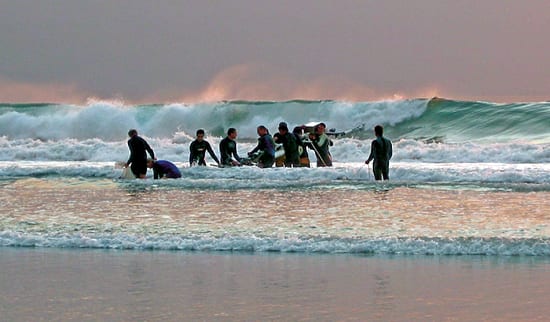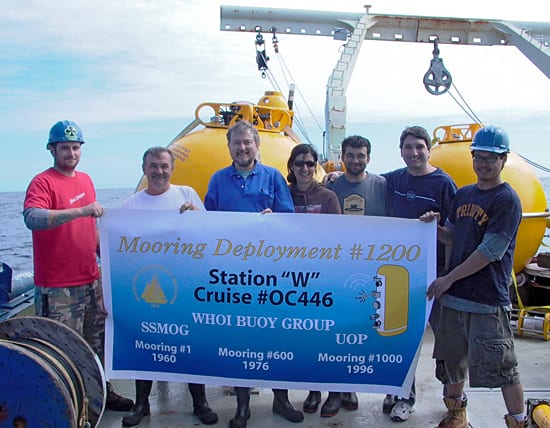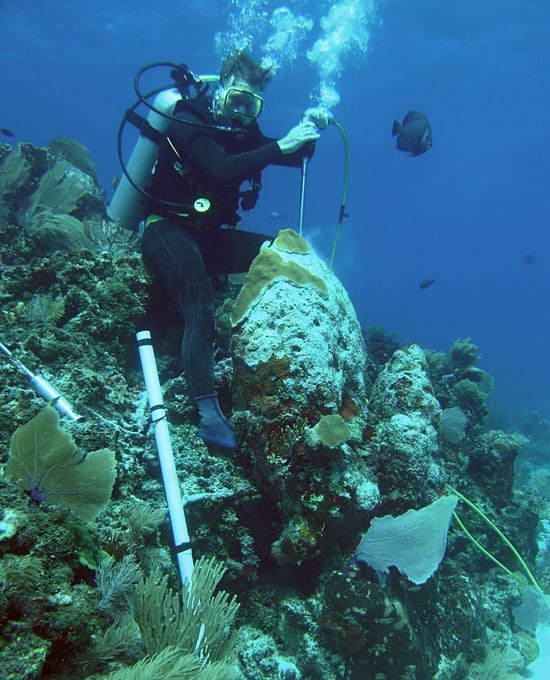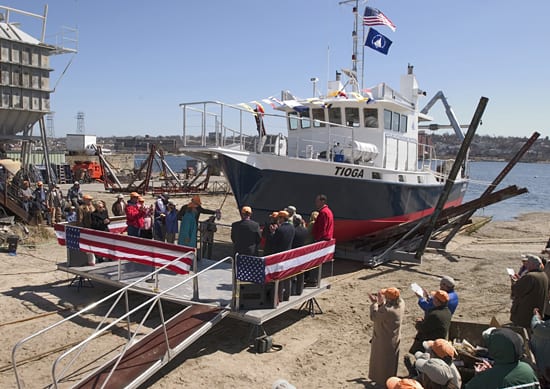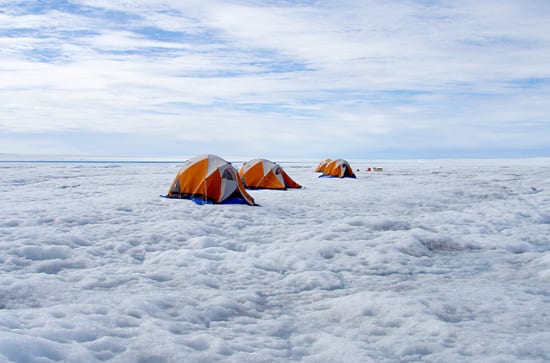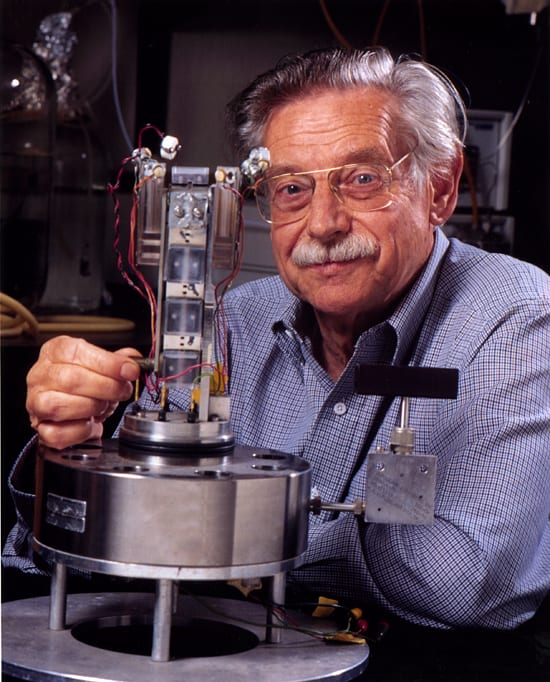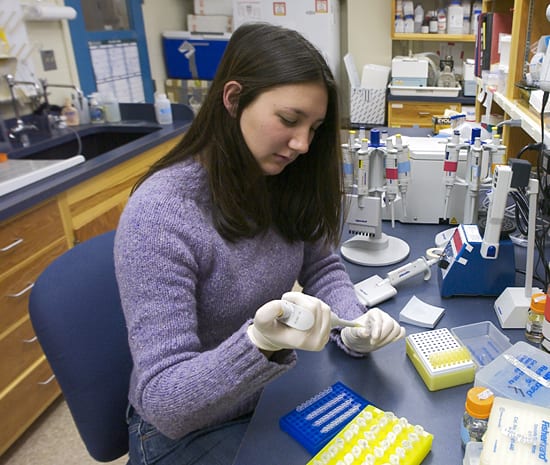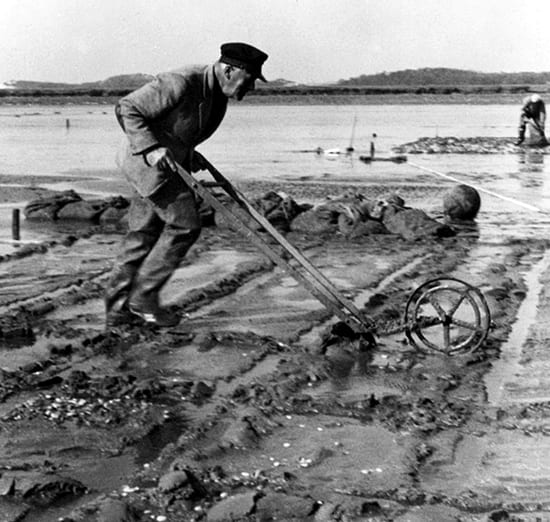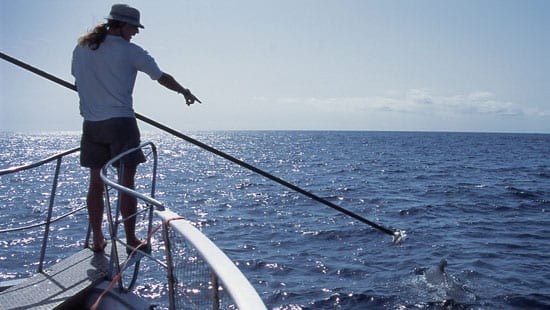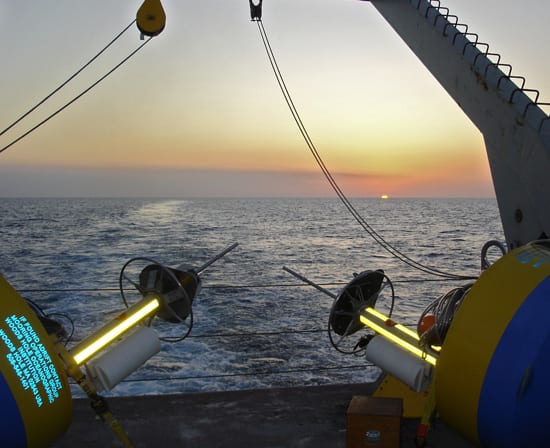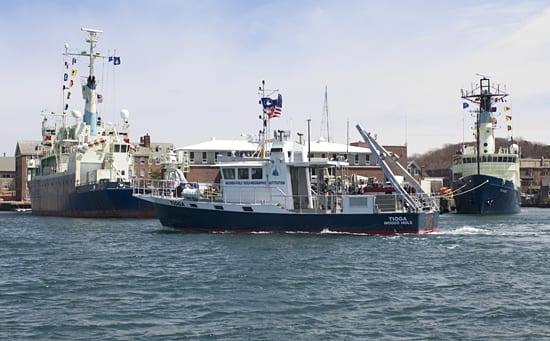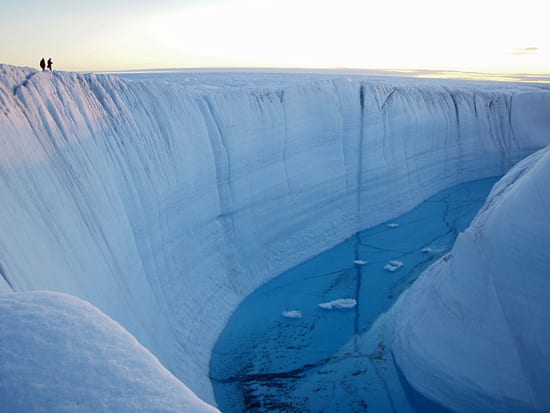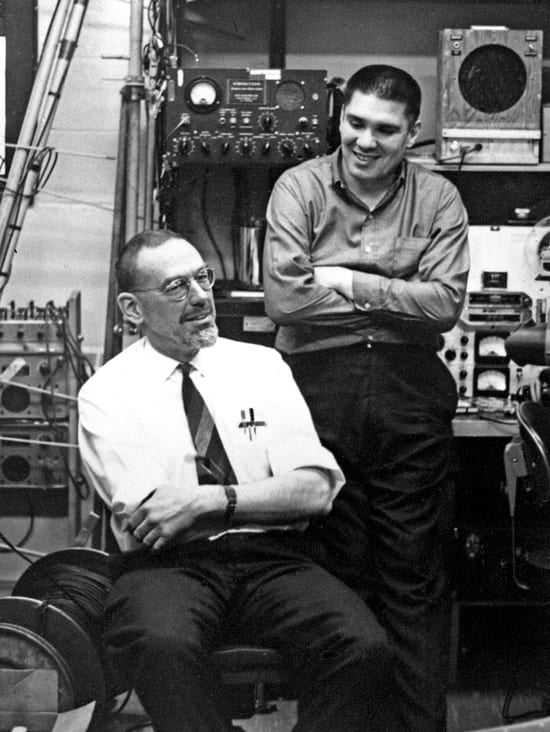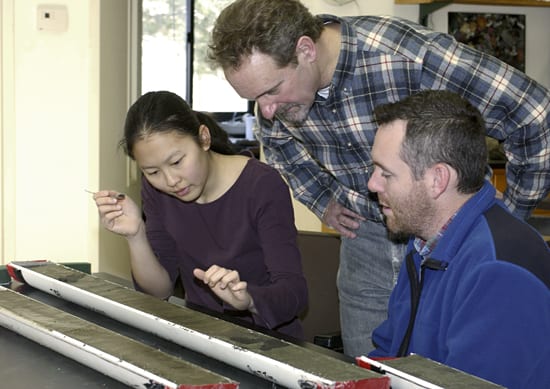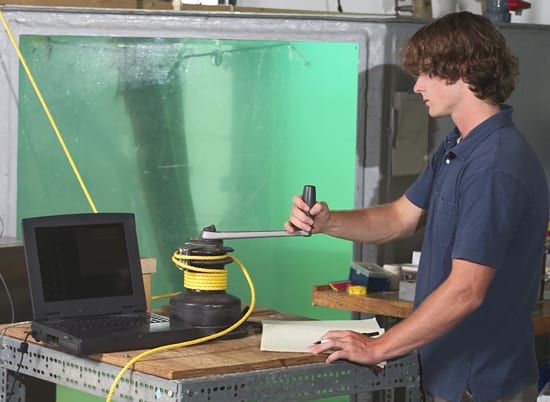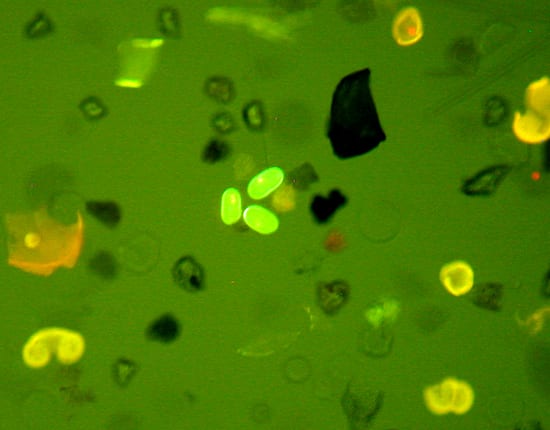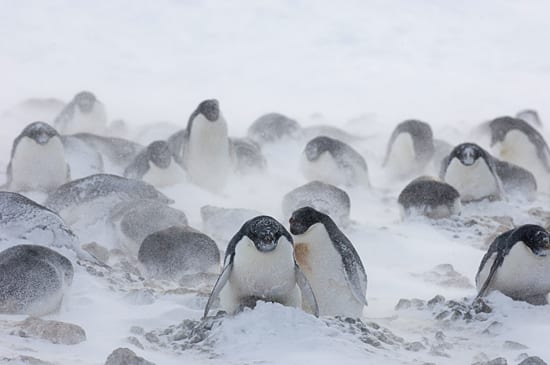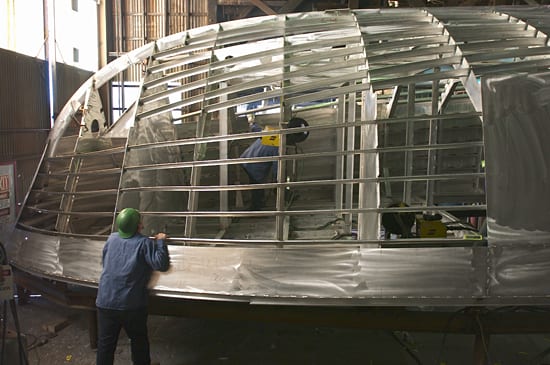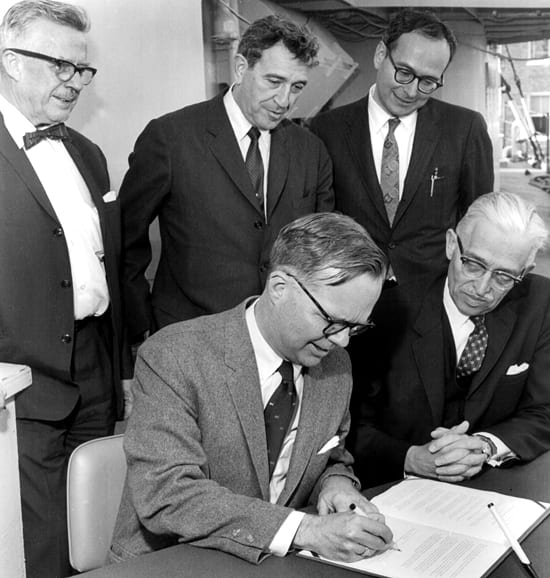Multimedia Items
Surf’s Up for Science
Researchers from WHOI and the Scripps Institution of Oceanography carry an instrument tower into the surf near La Jolla, California, to measure the movement of water beneath the breaking waves.…
Read MoreThe Good Old Days?
Electronic equipment and a snarl of wires fills a lab on the research vessel Chain in February 1966. WHOI’s first at-sea computer was an IBM installed on Chain in 1962;…
Read MoreWell Anchored
This May, WHOI buoy technicians deployed their 1,200th mooring, the most recent coming in the North Atlantic as part of the Line W array. Since 1960, the WHOI Buoy Group…
Read MoreDrilling for Climate Clues
WHOI geochemist Konrad Hughen drills for a core sample from a coral located in shallow water in the Honduras Bay Islands. Researchers can use cores to assess the current health…
Read MoreLaunching Into Coastal Research
WHOI employees, benfactors, and shipyard workers gathered on March 29, 2004, for the ceremonial blessing and launch of the coastal research vessel Tioga. The name Tioga comes from the Iroquois…
Read MoreCold Comfort
For several weeks in the summers of 2006 and 2007, researchers from WHOI and the University of Washington camped on top of Greenland’s ice sheet in order to study the…
Read MoreScience is an Adventure
Born in Holzminden, Germany, on May 23, 1927, Holger Jannasch pioneered the field of deep-sea microbiology. Inspired by the condition of the food in the infamous Alvin lunch box (1969),…
Read MoreLooking in the Genes for a Guide to Living
MIT/WHOI Joint Program student Diane Poehls Adams (now a postdoc at the National Institutes of Health) prepares biological samples for genetic analysis in the spring of 2004. Poehls Adams worked…
Read MoreSeeds of Aquaculture
From the late 1940s to the 1960s, a research team led by WHOI biologist Alfred Redfield investigated clam farming and the biology of softshell clams in a large harbor in…
Read MoreHeavy Lifting
MIT/WHOI Joint Program student Kjetil Våge operates a winch on the working deck of the research vessel Oceanus during an expedition in the North Atlantic in November 2007. Våge, Dave…
Read MorePilot and Beaked Whales off the Canary Islands
Tagging the whales to study their behavior
I’ll Follow the Sun
The Sun sets over the Atlantic Ocean near Andros Island, Bahamas, on April 19, 2008. Researchers from WHOI’s Acoustic Communications Group deployed and retrieved buoys—two are resting on the fantail…
Read MoreDifficult But Necessary Work
WHOI biologist and veterinarian Michael Moore (red jacket) and David Taylor, a retired high school biology teacher and WHOI guest investigator, prepare to perform a necropsy on a right whale…
Read MoreFamily Reunion
It may sound odd for an oceanographic institution, but it is actually an unusual occurrence when more than one research vessel is docked at WHOI’s Iselin Marine Facility. The ships…
Read MoreWe Would Shout, and Swim About, the Coral that Lies Beneath the Waves
A vibrant patch of coral grows in the Red Sea off the coast of Saudi Arabia. WHOI geochemist Konrad Hughen, biologist Simon Thorrold, and colleagues are departing today on a…
Read MoreCarving a Scientific Niche
Scientists walk along the edge of a large canyon carved by meltwater stream flow across the surface of the Greenland ice sheet. The lines along the canyon wall show the…
Read MoreEavesdropping on Whales
Bill Schevill, left, founded the field of marine mammal bioacoustics just after World War II. When Bill Watkins, right, joined him at WHOI in 1958, they began what current WHOI…
Read MoreCore Team
Former MIT/WHOI graduate student Mea Cook (now a Professor at Williams College) examines a sediment core taken from the Bering Sea, along with her advisors Lloyd Keigwin (middle) and Jeff…
Read MoreLines of Research
Derek Cavatorta, a WHOI summer student fellow in 2003, turns a winch to drag marine-grade rope lines across a piece of whale baleen (suspended in the tank). Cavatorta worked with…
Read MoreStand Outs
Stained with primulin dye and viewed under a microscope (magnfied 100X), cysts of the harmful algae Alexandrium fundyense and its less dangerous cousin Alexandrium tamarense stand out in yellow and…
Read MoreHunkering Down
“I’ve never seen a cold penguin,” said ornithologist Grant Ballard of the Point Reyes Bird Observatory. “It can be minus 30, and they’ll just be doing the same things they…
Read MoreFramed
Workers at Gladding-Hearn Shipbuilding in Somerset, Mass., assemble the aluminum hull of the 60-foot coastal research vessel Tioga in the summer of 2003. The aluminum “longitudinals” in the frame are…
Read MoreIt Was Forty Years Ago Today…
Howard Johnson (seated, center), president of the Massachusetts Institute of Technology (MIT), and Paul Fye (seated, right), director of WHOI, sign a memorandum creating the MIT/WHOI Joint Program in Oceanography…
Read More
